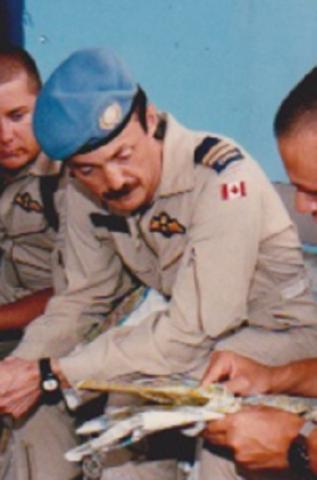
Joined
1979
International deployments
- Norway 1986
- Central America 1990
- Haiti 1997, 2004, 2010
National deployments
- Oka 1990
- Saguenay flood 1996
Luc Lacasse was born in Sherbrooke, Quebec, in 1957. He grew up and went to school there and also took part in the Cub Scout and Scout movements. To help pay for some of his education, Luc joined the militia, with the Fusiliers de Sherbrooke, in 1973.
While in university, Luc spoke with an acquaintance who had just joined the military air force as a pilot. He was also interested in this career path and decided to join the regular forces in 1979.
At 22 years old, Luc enlisted as a pilot and obtained the rank of officer cadet. After completing his training and spending three years as an instructor, he was transferred to helicopters. He would spend the rest of his career in that specialty.
In 1986, he went on his first international deployment, a month-long exercise in Norway during the Cold War.
“Like any military presence near a border, you want the enemy to get a look at you so you can see what they can do. The enemy does the same thing to you – they monitor your communications.”
A surveillance pilot’s role in the Kiowa, a small military helicopter, is varied. This includes guiding fighter planes and bombers to targets, directing artillery fire, marking targets and guiding larger helicopters that are transporting troops close to the enemy zone. Luc excelled at those skilled tasks.
Canadian pilots show great boldness and skill. They are trained to navigate by memory, at very low altitudes, after studying maps. Sometimes, they fly as low as one metre from the ground.
“We call it blind navigation, without a map. When you’re good at doing this, you’re really good with a map in your hands.”
After Luc got back to Canada, he spent three years at Valcartier with 430 Squadron before being posted to Edmonton, to fly with 408 Squadron. In 1990, he took part in a United Nations mission in Honduras. The troops were well positioned to intervene in neighbouring countries that wanted to end the civil war, such as Nicaragua and Guatemala. However, they faced a few logistical challenges. Roads in the jungle were difficult to drive on, especially during the rainy season. Moving observers, doctors and nurses became Luc’s daily routine aboard his Jet Ranger helicopter.

Luc Lacasse on a mission in Honduras, in 1990. Photo: Luc Lacasse collection
His detachment was soon relocated to Managua, Nicaragua. The situation on the ground was fairly stable, but living off the local economy meant being cautious and limiting evening outings.
The rebels in Nicaragua agreed to surrender their weapons in exchange for food, clothing and documents to integrate civilian life. Slowly, democracy took root. Luc left Central America after six months with a sense of accomplishment.
When he returned in 1990, Luc was immediately deployed to the Oka crisis in the Montreal area. He had to leave his pregnant wife for another month. He flew mostly at night to monitor sensitive sites.
In 1991, Luc was posted to Saint-Hubert. He became Chief of Staff to a General who oversaw the six Canadian tactical aviation squadrons. He took care of the “paperwork,” but his General asked him to continue flying to maintain his qualification. Luc could still fly, much to his satisfaction. He experienced the transition from three types of helicopters (Twin Huey, Kiowa, Chinook) to just one (Griffon – Bell 146).
Luc also served during the Saguenay flood in 1996.
Throughout his career, Luc was deployed to Haiti three times (1997, 2004, 2010). Seeing poverty and famine close up was unsettling, so it was sometimes hard on morale. His last deployment to Haiti, in 2010, was after the terrible earthquake.
“With a helicopter, you are close to the ground, close to people. You can land just about anywhere. The helicopter is very flexible, it allows you to see things that you can’t see with an airplane.”

Luc Lacasse (with the beret and sunglasses) surrounded by children in Haiti, in 1997. Photo: Luc Lacasse collection
With courage, integrity and loyalty, Luc Lacasse has left his mark. He is one of our Canadian Veterans. Discover more stories.